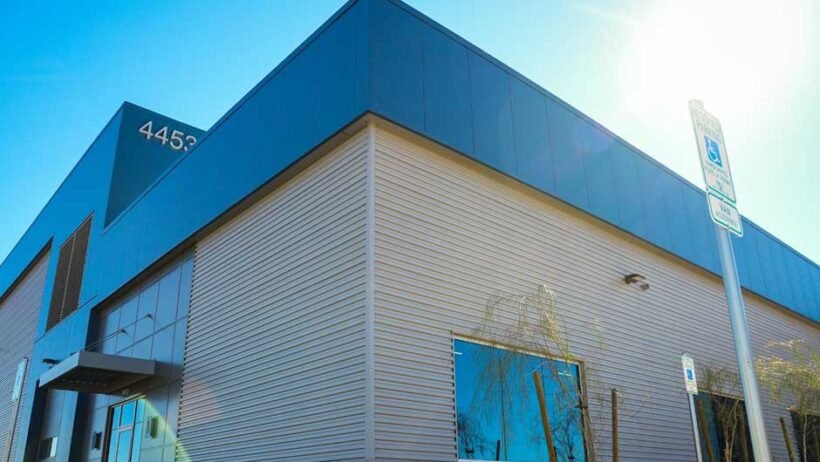When you’re a project manager, architect, contractor, or distributor working on commercial or industrial projects, you know every decision counts. Choosing the right cladding system can impact cost efficiency, project timelines, building aesthetics, and long-term performance. Let’s look at the real facts: why aluminum siding for commercial and industrial buildings is the smart choice, what you should expect from it, and what system details matter most for large-scale applications.
Why Choose Aluminum Siding for Commercial and Industrial Buildings
When you’re building warehouses, retail centres, offices, factories or institutional buildings, you’re under different pressures than a single-family house. Here are key reasons why aluminium siding stands out:
Lightweight + easy installation:
Aluminium panels are much lighter than stone, heavy fibre-cement, brick veneers or many composite systems. That means easier handling on site, faster installation, lower structural load.
Durability in harsh environments:
Commercial buildings often face large façades, heavy duty usage, weather extremes, salt, industrial exposure. Good aluminium siding resists corrosion, UV-damage, moisture.
Low maintenance:
Fewer repairs, less frequent repainting, less downtime for maintenance in a commercial schedule.
Design flexibility and branding:
For commercial buildings you often want a visual identity, bold façade, special texture or wood-look finish, or corporate colour. Aluminium can deliver that without sacrificing performance.
Fire & code compliance: Many systems meet commercial building codes for fire, wind, strength—important for industrial/commercial acceptance.
What decision-makers need to check before specifying aluminum siding
When you’re dealing with large-scale buildings, you can’t just say “we’ll use aluminium siding” and assume all systems are equal.
Here’s what you must check when selecting aluminum siding for commercial and industrial buildings:
- Material specification – pure aluminium vs composite
For commercial/industrial use choose true aluminium alloy panel, not a heavy composite with filler materials that add weight and reduce performance. As one source states: good systems are “100% aluminium alloy (not composite)” for longer lifespan, stronger protection.
Check alloy grade, finish, panel thickness/gauge, coating system. Higher gauge (thicker) panels = less denting, better durability.
- Installation system – easy to install, labour-friendly
On commercial jobs, labour cost and schedule are big. Look for click-and-lock, slide-in systems, concealed fasteners. For example: “Click and Slide systems… up to 4× faster installation compared to traditional siding.”
Make sure the system works for large-area installation: long panels, minimal seams, quick fixing, scalable.
- Texture, finish and aesthetics
Even commercial/industrial buildings benefit from good appearance. Wood-look aluminium, matte greys, light tones give architect/designer flexibility.
Finish must hold up to sun, weather, wind, industrial pollutants—check coatings (PVDF, powder coat) and warranties.
- Weight and structural implications
The lighter the panel system (when still meeting performance), the easier logistics: less crane‐time, fewer structural supports, faster install. A panel manufacturer noted that for large-scale projects panels should be “designed for large-scale … lightweight aluminium panels, easy to transport – No need for heavy equipment.”
- Maintenance & lifecycle cost
- Large commercial buildings face big maintenance budgets; siding that reduces those costs is a big win. Choose systems that offer strong durability, minimal maintenance.
- Suitability for commercial/industrial conditions
Best textures and finishes for commercial/industrial aluminium siding
In commercial & industrial buildings you often want more than “just plain metal siding”. Here’s what works:
- Wood-look aluminium finish: gives a premium look in offices or mixed-use buildings yet retains durability.
- Matte or light-grey metal finishes: good for modern industrial style—clean, minimalist, reflective control.
- Solid metallic or corporate colour finishes: Aligns with branding for retail or commercial façades.
- Custom textures or perforations: Some commercial systems allow perforated aluminium panels, 3D forms, advanced designs for facades.
How this choice helps you reduce cost and risk
For decision-makers on commercial/industrial projects, the advantages translate into clear business benefits:
- Labour savings: Faster install systems (click/slide) mean fewer hours onsite, less scaffolding time, quicker project turnover.
- Transport/logistic savings: Lightweight panels are easier to ship, handle, and install which reduces logistic cost.
- Lower maintenance & repair cost: Fewer replacement cycles, less maintenance means lower operating cost for the building owner.
- Longevity = better ROI: A system that lasts 30-40+ years means less capital reload, better long-term value.
- Less risk of failure: Good aluminium siding resists moisture, rust, pests, warping, these issues can cause big problems in industrial/commercial buildings.
Summary guidance for your next project
Here’s a decision-checklist you can use when evaluating aluminium siding for commercial and industrial buildings:
- Confirm material: pure aluminium alloy (not composite), check gauge, finish, warranty.
- Review installation system: does it allow click/slide or easy mounting? Are execution details clear?
- Compare textures/finishes: ensure design vision matches product offering (wood-look, metal, custom colour).
- Check logistics/weight: verify panel weight, length, handling, transport implications.
- Evaluate maintenance/lifecycle: check maintenance requirements, finish durability, warranties, expected lifespan.
- Confirm building suitability: fire ratings, code compliance, weather/exposure conditions, durability.
- Discuss with installer/contractor: does their team have experience with the system? Is labour cost accounted?
In conclusion
For commercial and industrial buildings you’re not just picking a material, you’re picking a system that needs to deliver performance + aesthetics + cost-efficiency. Aluminium siding, when specified and installed correctly, gives you a winning triad: lightweight for logistics, durable for harsh conditions, design-flexible for façade vision, and efficient in labour and maintenance. Align those factors right and you’ll deliver a strong outcome for your project and your client.
FAQs
Can aluminium siding systems handle large commercial façades and industrial buildings?
Yes, when you pick the right system. Good commercial-grade aluminium siding systems are developed exactly for large-scale projects—lightweight panels, click/slide systems, commercial finishes and structural compatibility
What textures or finishes should we specify for commercial/industrial aluminium siding?
You should look at finishes like wood-look aluminium for premium façades, matte or light-grey metal for modern industrial style, solid corporate colours for branding, or custom perforated/3D textures for signature façades. Good aluminium manufacturers support these options.
How much can we save in labour and installation time by choosing an aluminium siding system?
Significant savings are possible: one manufacturer claims their click & slide system allows installation up to 4× faster than traditional siding on commercial projects. Less install time = less labour cost, less schedule risk.








